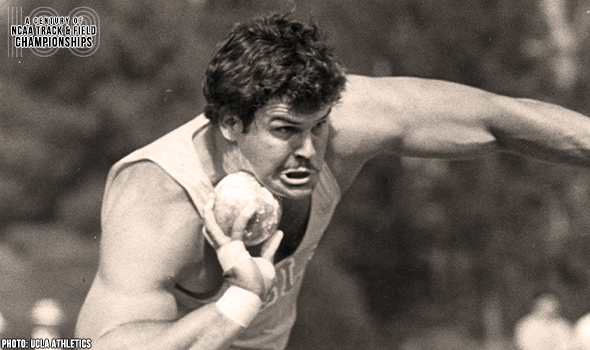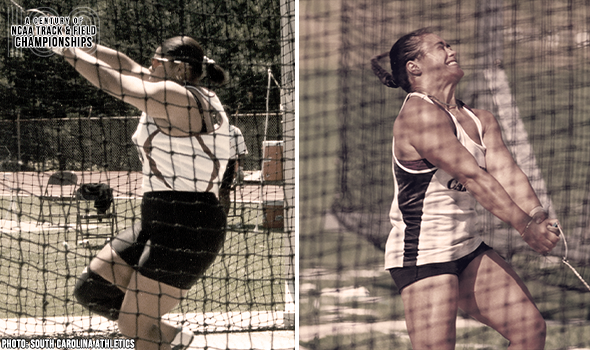
Simpson Sprints To All-Time Mark In 1929
George Simpson of Ohio State was ahead of his time.
In 1929, Simpson used starting blocks – then a recent innovation – in the final of the 100 yards at the NCAA Track & Field Championships. To wit, the starting blocks hadn’t be around all that long, as the invention was credited to Australian Charlie Booth and his father earlier that year.
Simpson, then a junior for the Buckeyes, scorched the cinder in 9.4 seconds to not only win one of his three career NCAA titles, but set an apparent world record in the process. And while the NCAA allowed the use of starting blocks, the world and U.S. governing bodies did not at the time. Therefore, his 9.4 was never ratified as a world record (It was eventually recognized as the American record 15 years later in 1944).
The final field of the 100 yards was loaded, featuring four men who had equaled the existing world record of 9.5. The others, in order of finish: defending champ Claude Bracey of Rice, Eddie Tolan of Michigan and Cy Leland of TCU. Tolan and Simpson, in fact, equaled the 9.5 WR in prelims.
Simpson was a double winner in 1929, adding a 220-yard victory to help lead Ohio State to its first (and still only) team title at this meet. The Buckeyes won the meet with just four athletes – the smallest winning team until USC (1943) and Arkansas (1996) would match them. Amazingly, Ohio State could have won with just three athletes as the trio of Simpson (20 points), hurdler Richard Rockaway (18) and discus thrower Pete Rasmus (10) accounted for 48 of the Buckeyes’ 50 points (Runner-up Washington had 42).
The NCAA and collegiate track & field will mark a momentous milestone in the spring of 2021 -- the 100th anniversary of the NCAA Championships and with that, the NCAA Track & Field Championships. In June 1921, the University of Chicago hosted the first track & field championships in NCAA history.
This point can’t be emphasized enough: Not only was the event the first for NCAA track & field, but the first championships for any sport under the sponsorship of the NCAA.
To celebrate, over each of the next 365 days, the U.S. Track & Field and Cross Country Coaches Association (USTFCCCA) will celebrate moments, student-athletes, and coaches that have made a century’s worth of championships special. From humble beginnings to important historical milestones to the modern-day, collegiate track & field has evolved with the American society.
The 2021 edition of the NCAA Division I Outdoor Track & Field Championships begin with preliminary round action on May 27-29 in Jacksonville, Fla., and College Station, Texas. The championships final site and culmination of the celebration is slated for June 9-12, 2021 at the newly rebuilt Hayward Field in Eugene, Ore.

Carr Displayed His World Record Speed
Henry Carr set a meet record in the 220 yards of 20.5 at the 1963 NCAA Outdoor Track & Field Championships.

Joaquim Cruz’d To Meet Record, 800-1500 Double
Joaquim Cruz won three career titles at the NCAA DI Outdoor T&F Championships. In 1983, he set a meet record in the 800 of 1:44.91 & completed the 800-1500 double in 1984.

Back-To-Back 200-Meter Crowns For Annelus
Anglerne “Angie” Annelus won back-to-back 200m titles at the NCAA DI Outdoor T&F Championships in 2018 & 2019. Her 22.16 winner from 2019 is the 4th fastest mark in collegiate history.

Indoors? Outdoors? Johnson Starred In The PV
Jan Johnson won the pole vault title at the 1970 NCAA Division I Outdoor T&F Championships and tied the meet record of 17-7.

Beard Capped Sensational Year At NCAAs
Jessica Beard won the 400 & then split the fastest 4×400 leg ever recorded at the NCAA DI Outdoor T&F Championships to lead Texas A&M to a relay crown.

Biles Brothers Boast Historic Winning Feat
Martin Biles & Robert Biles were the first siblings to win the same event at the NCAA DI Outdoor T&F Championships. Marty won the javelin in 1940 & 1941, while Robert did so in 1942.

Branta Set NCAA MRs In 1500, 3000
Cathy Branta set meet records in back-to-back years at the NCAA DI Outdoor T&F Championships: 8:59.57 in the 3000 (1984); 4:12.64 in the 1500 (1985) as part of a 1500-3K double.

Brophy Led “Deca Central” With MR In 1992
Brian Brophy led a 1-2 finish by Tennessee athletes in the decathlon at the 1992 NCAA Division I Outdoor T&F Championships. He won with a meet record of 8276 points.

UCLA’s Brenner Won Amazing SP Duel In 1984
John Brenner completed the discus-shot put double at the 1984 NCAA Division I Outdoor T&F Championships and won the shot put after an incredible duel against Michael Carter.

Ellerbe, Misipeka Dominated The Hammer
Dawn Ellerbe and Lisa Misipeka went 1-2 in each of the first two years that the women’s hammer was contested at the NCAA DI Outdoor Track & Field Championships.

